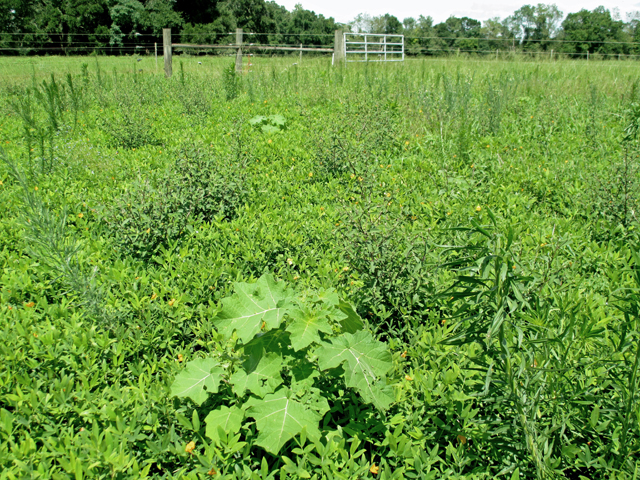
Perennial peanut producers have encountered numerous weeds that are difficult to control with 2,4-D amine and Impose (imazapic). GlyStar Plus now provides another option for perennial peanut producers to use to reduce weed populations in their hay fields. Photo credit: Doug Mayo
Brent Sellers, UF/IFAS Extension Weed Specialist
Over the past several years, perennial peanut producers have encountered weeds that are much more difficult to control with the standard broadleaf and grass herbicides such as 2,4-D amine and Impose (imazapic). We had observed perennial peanut tolerance to glyphosate when attempting to maintain our research plot alleys to a specific size; we realized that perennial peanut was relatively tolerant to glyphosate than previously known. This prompted some research that was conducted over the past few years.
Glyphosate was applied at 4, 8, 16, 32, and 64 oz/acre during the summer growing season at Zolfo Springs (weed-free; ‘UF-Tito’) and Ona (not weed-free; ‘Ecoturf’, ‘Florigraze’, ‘UF-Tito’). Two weeks prior to herbicide application, perennial peanut was clipped to 3 inches. Both locations consisted of an established stand of perennial peanut. However, rhizomes were harvested from the Zolfo Springs location within 12 to 18 months prior to application.
Injury at the Zolfo Springs location was less than 20% when Glystar Plus was applied at less than 32 fl oz/A (Figure 1). 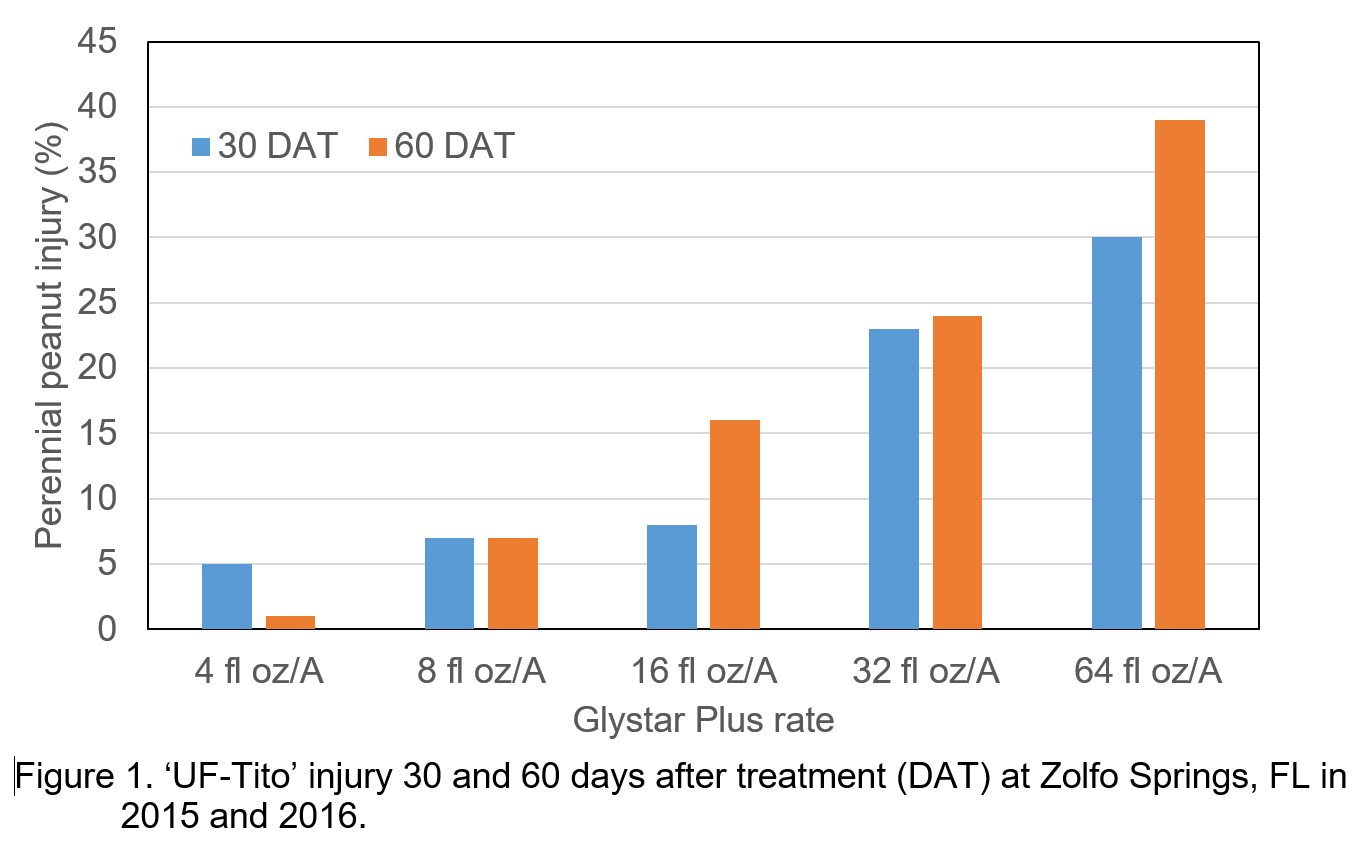
Injury at Zolfo Springs did not exceed 40%. Perennial peanut yield was 19-27% lower than the untreated control at 60 days after treatment when applied at 16-32 fl oz/A, and yield was 58% lower when applied at 64 fl oz/A (Figure 2). 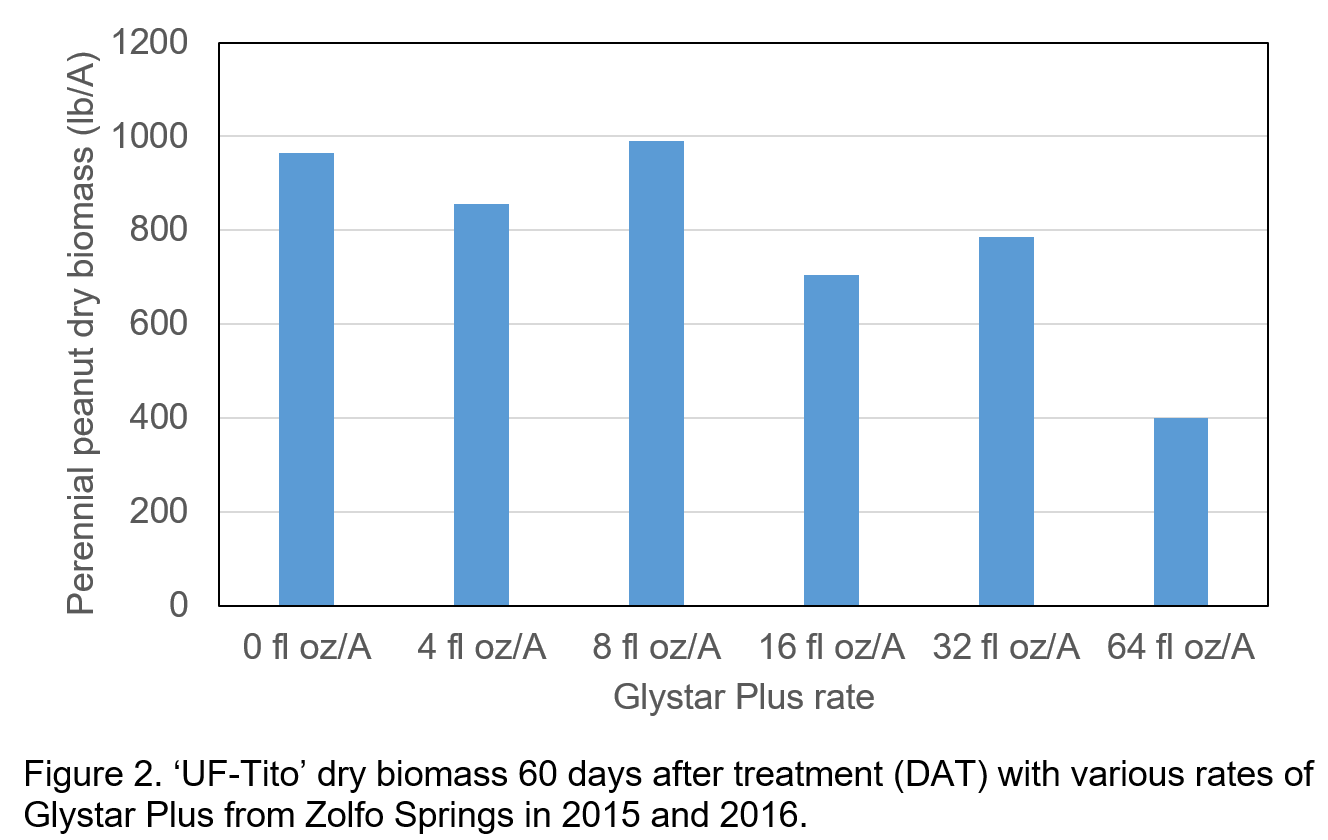
Results were slightly different at Ona with a fully established, non-disturbed stand that was planted in 2005. Injury from Glystar Plus did not exceed 20% at rates of 32 fl oz/A or less (Figure 3). 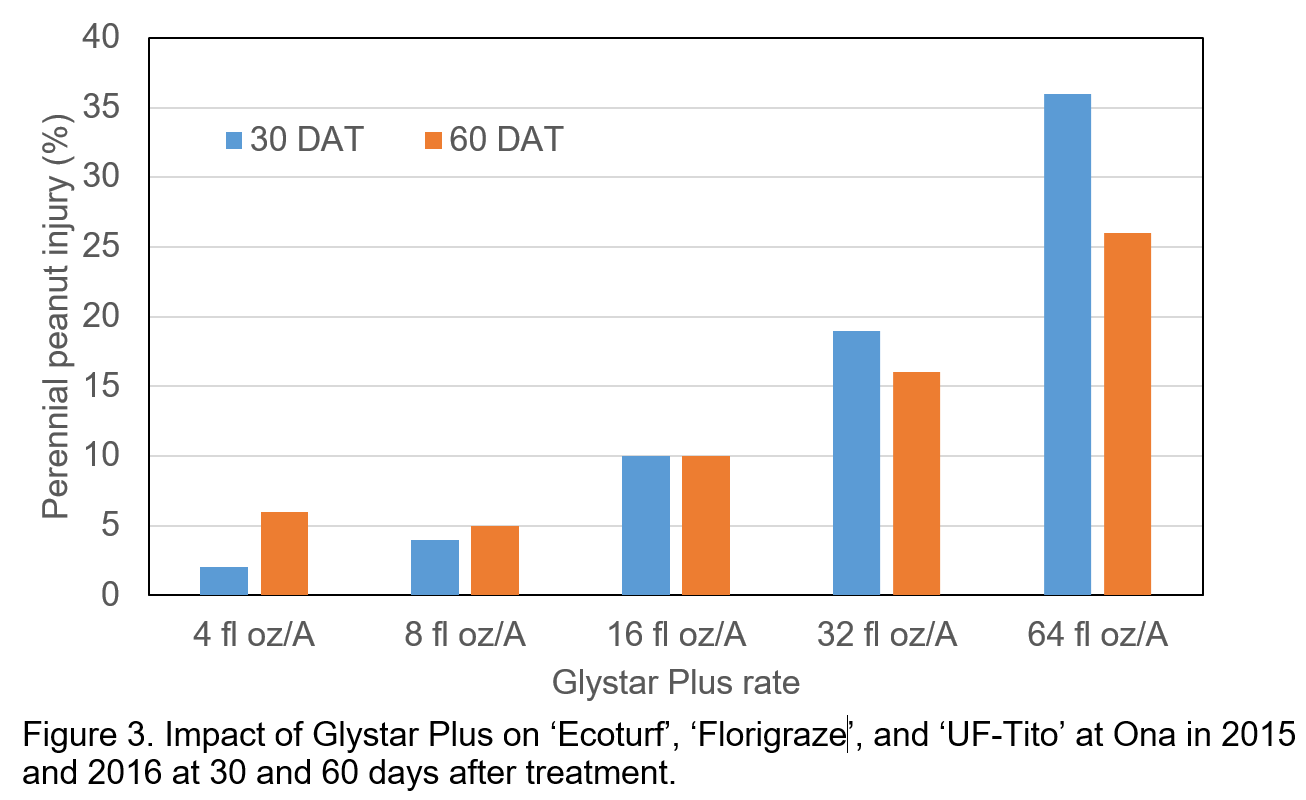
Additionally, injury was transient, and began to decrease from 30 to 60 days after treatment. Perennial peanut biomass was not affected by Glystar Plus application at rates of 32 oz/A or less, and was reduced by only 22% at 64 fl oz/A (Figure 4).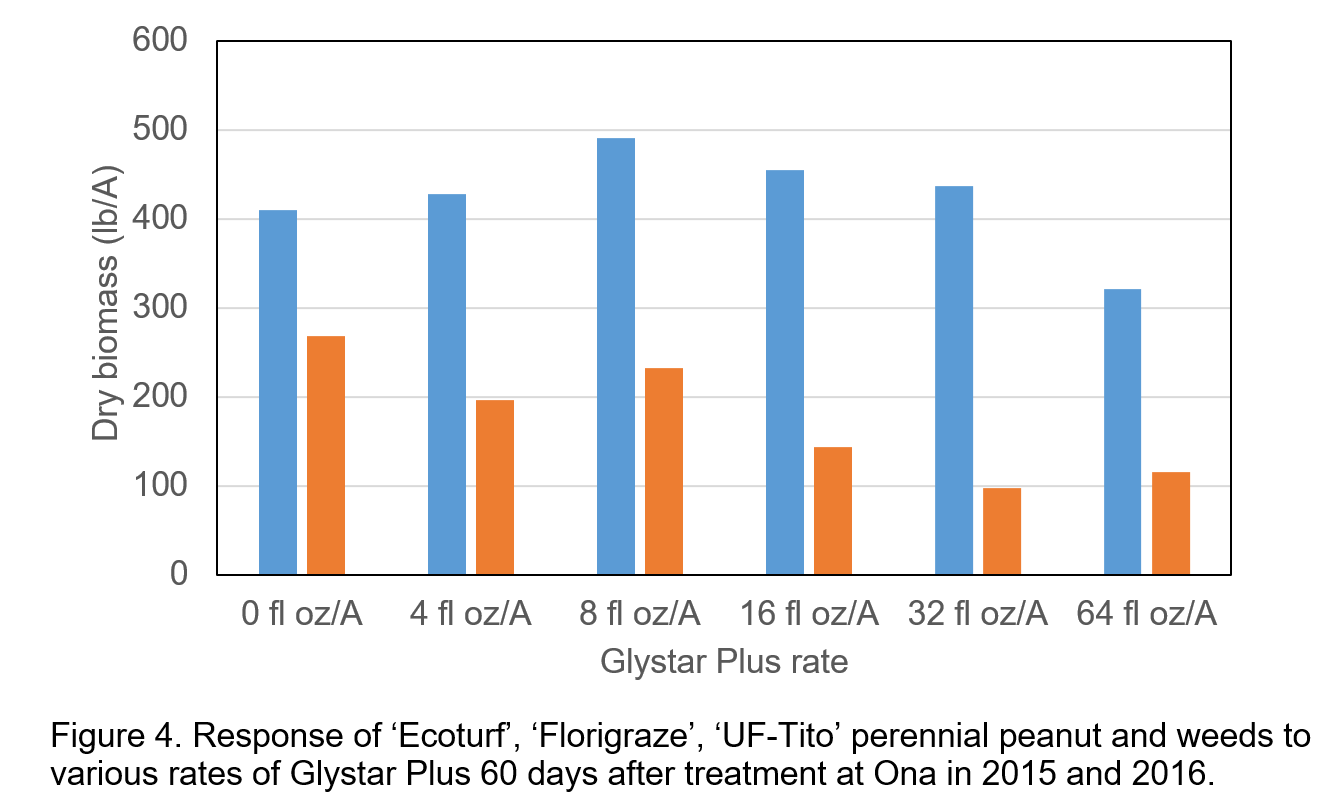 The reason for the lack of differences between the untreated control and Glystar Plus at 32 fl oz/A may be due to the presence of weed competition within the plots. Weed biomass following application of 32 and 64 fl oz/A was similar, indicating that increasing the rate from 32 to 64 fl oz/A was not advantageous based upon the weed species present in this study. The predominant broadleaf weed present at the Ona location was goatweed, which is fairly tolerant to glyphosate at these application rates.
The reason for the lack of differences between the untreated control and Glystar Plus at 32 fl oz/A may be due to the presence of weed competition within the plots. Weed biomass following application of 32 and 64 fl oz/A was similar, indicating that increasing the rate from 32 to 64 fl oz/A was not advantageous based upon the weed species present in this study. The predominant broadleaf weed present at the Ona location was goatweed, which is fairly tolerant to glyphosate at these application rates.
These data, along with other data collected throughout the years, were used to submit an application to FDACS for a supplemental label for use in perennial peanut, which was approved in mid-June, 2017. Producers must use this specific glyphosate product, as it is the only one that has a supplemental label for use in perennial peanut. This approval allows the use of Glystar Plus during the dormant season, through wiper applications during the growing season, and in-season broadcast applications if the height difference between the weeds and perennial peanut is not sufficient for effective control with a wiper (Table 1). The links to the supplemental and full herbicide label are provided below:
Download the supplemental and full labels for complete use instructions:
Supplemental label: Gly Star Plus label for FL perennial peanut
Herbicide Label: GlyStar Plus label
—
Highlights from the GlyStar Plus
Supplemental Perennial Peanut Label
Product Description
This product is a post-emergent, systemic herbicide with no soil residual activity. It is generally non-selective and gives broad-spectrum control of many annual weeds, perennial weeds, woody brush and trees. It is formulated as a water-soluble liquid. It may be applied through most standard industrial or field-type sprayers after dilution and thorough mixing with water or other carriers according to label instructions.
AVOID CONTACT OF HERBICIDE WITH FOLIAGE, GREEN STEMS, EXPOSED NON-WOODY ROOTS OR FRUIT OF CROPS, DESIRABLE PLANTS AND TREES, BECAUSE SEVERE INJURY OR DESTRUCTION MAY RESULT.
Restrictions for use in Perennial Peanut
- 14 day grazing restriction after wiper application
- 56 day grazing or hay harvest restriction for spot treatment or post-clip applications
- Do not apply more than 2 Quarts/Acre for Pre-plant application
- Do not apply more than 1.5 Quarts/Acre for Dormant season application
- Do not apply more than 1.5 Quarts/Acre for all In-Season applications
- Do not apply more the 5.0 Quarts/Acre per year for all uses combined
Table 1. Types of applications and rates for Glystar Plus in perennial peanut in Florida.
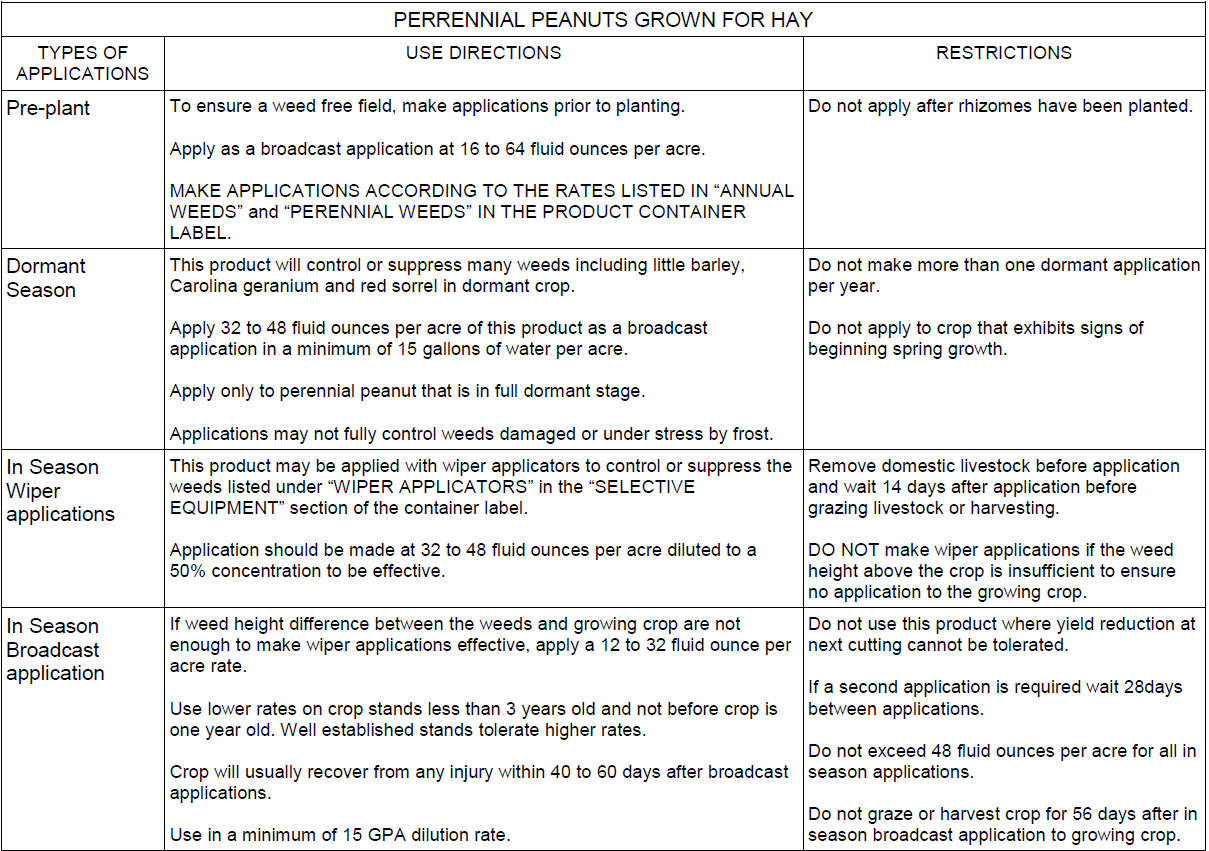
This information was copied directly from the GlyStar Plus supplemental label.
Please let me know if you have any questions:
Brent Sellers, Extension Weed Specialist
UF-IFAS Range Cattle Research and Education Center
863-735-1314 ext 207
- UF/IFAS Weed Extension website
- University of Florida Pasture Weed Identification and Control Facebook page
- The Use of Drones in Pasture Weed Management - June 20, 2025
- Goatweed Control in Pastures and Hayfields - October 4, 2019
- Thinning the Pawpaw Patch in Your Pastures - May 18, 2018
